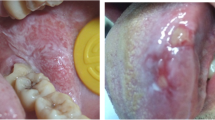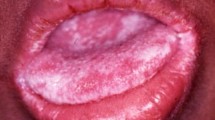Abstract
Objectives
Candida albicans is the most common fungal pathogen in humans, but other Candida species cause candidosis. Candida species display significant differences in their susceptibility to antimycotic drugs. Patients with symptomatic or erythematous oral lichen planus (OLP) commonly have Candida infection requiring correct identification of Candida species in order to initiate adequate antimycotic therapy. Therefore, conventional cytosmear and culture tests were compared with genetic diagnostics on oral rinse followed by agar culture and material collected by cytobrush from OLP patient mucosal lesion.
Methods
The genetic approach was validated on a reference panel of 60 well-defined unrelated fungal species. The study included 37 OLP patients. Oral candidosis (OC) was established based on clinical signs of OC and/or oral mucosal symptoms and at least one hypha in lesional cytosmear. Antimycotic treatment was initiated after OC diagnosis, and symptomatic treatment was initiated in no-candidosis situations.
Results
The composition of Candida species in oral rinse/culture test was different from that of lesional cytobrush sampling as more non-albicans species were detected by the latter. Unexpectedly, Candida dubliniensis was found to be overrepresented among patients with a history of antimycotic treatment indicating unintentional iatrogen selection. Of the 22 OLP patients receiving treatment, 27 % of these should have been offered alternative therapy based on the improved diagnostic approach.
Conclusion
This study highlights the importance of lesional sampling in OLP patients with suspected OC.
Clinical relevance
Correct fungal identification is critical in order to initiate adequate antimycotic therapy, thus minimizing iatrogen selection of non-albicans species.
Similar content being viewed by others
Reference
Axell T (1976) A prevalence study of oral mucosal lesions in an adult Swedish population. Odontol Revy 27(36):1–103
Thorn JJ, Holmstrup P, Rindum J, Pindborg JJ (1988) Course of various clinical forms of oral lichen planus. A prospective follow-up study of 611 patients. J Oral Pathol 17(5):213–218
Pindborg JJ, Reichart PA, Smith CJ, Van Der Waal I, WHO (1997) Histological typing of cancer and precancer of the oral mucosa. Springer, Berlin
Scully C, Beyli M, Ferreiro MC et al (1998) Update on oral lichen planus: etiopathogenesis and management. Crit Rev Oral Biol Med 9(1):86–122
Williams DW, Kuriyama T, Silva S, Malic S, Lewis MA (2011) Candida biofilms and oral candidosis: treatment and prevention. Periodontol 55(1):250–265
Barkokebas A, de Alburquerque T, Cavalho A, de Souza PR, Gomez RS, Xavier GM (2011) Mannose-binding lectin gene (MBL-2) polymorphisms in oral lichen planus. Clin Oral Investig 15(5):699–704
Williams DW, Lewis MA (2000) Isolation and identification of Candida from the oral cavity. Oral Dis 6(1):3–11
Arendorf TM, Walker DM (1980) The prevalence and intra-oral distribution of Candida albicans in man. Arch Oral Biol 25(1):1–10
Zaremba ML, Daniluk T, Rozkiewicz D et al (2006) Incidence rate of Candida species in the oral cavity of middle-aged and elderly subjects. Adv Med Sci 51(Suppl 1):233–236
Loreto ES, Scheid LA, Nogueira CW, Zeni G, Santurio JM, Alves SH (2010) Candida dubliniensis: epidemiology and phenotypic methods for identification. Mycopathologia 169(6):431–443
Nguyen MH, Peacock JE Jr, Morris AJ et al (1996) The changing face of candidemia: emergence of non-Candida albicans species and antifungal resistance. Am J Med 100(6):617–623
Lundstrom IM, Anneroth GB, Holmberg K (1984) Candida in patients with oral lichen planus. Int J Oral Surg 13(3):226–238
Jainkittivong A, Kuvatanasuchati J, Pipattanagovit P, Sinheng W (2007) Candida in oral lichen planus patients undergoing topical steroid therapy. Oral Surg Oral Med Oral Pathol Oral Radiol Endod 104(1):61–66
Masaki M, Sato T, Sugawara Y, Sasano T, Takahashi N (2011) Detection and identification of non-Candida albicans species in human oral lichen planus. Microbiol Immunol 55(1):66–70
Martinez M, Lopez-Ribot JL, Kirkpatrick WR, Coco BJ, Bachmann SP, Patterson TF (2002) Replacement of Candida albicans with C. dubliniensis in human immunodeficiency virus-infected patients with oropharyngeal candidiasis treated with fluconazole. J Clin Microbiol 40(9):3135–3139
Al MA, Sullivan DJ, Polacheck I et al (2005) Novel 5-flucytosine-resistant clade of Candida dubliniensis from Saudi Arabia and Egypt identified by Cd25 fingerprinting. J Clin Microbiol 43(8):4026–4036
Ellepola AN, Samaranayake LP (2001) Adjunctive use of chlorhexidine in oral candidoses: a review. Oral Dis 7(1):11–17
Pedersen AM, Andersen TL, Reibel J, Holmstrup P, Nauntofte B (2002) Oral findings in patients with primary Sjogren's syndrome and oral lichen planus—a preliminary study on the effects of bovine colostrum-containing oral hygiene products. Clin Oral Investig 6(1):11–20
Tollemar J, Gross N, Dolgiras N, Jarstrand C, Ringden O, Hammarstrom L (1999) Fungal prophylaxis by reduction of fungal colonization by oral administration of bovine anti-Candida antibodies in bone marrow transplant recipients. Bone Marrow Transplant 23(3):283–290
White TC, Marr KA, Bowden RA (1998) Clinical, cellular, and molecular factors that contribute to antifungal drug resistance. Clin Microbiol Rev 11(2):382–402
Isham N, Ghannoum MA (2010) Antifungal activity of miconazole against recent Candida strains. Mycoses 53(5):434–437
Krogh P, Hald B, Holmstrup P (1987) Possible mycological etiology of oral mucosal cancer: catalytic potential of infecting Candida albicans and other yeasts in production of N-nitrosobenzylmethylamine. Carcinogenesis 8(10):1543–1548
Jayatilake JA, Samaranayake YH, Cheung LK, Samaranayake LP (2006) Quantitative evaluation of tissue invasion by wild type, hyphal and SAP mutants of Candida albicans, and non-albicans Candida species in reconstituted human oral epithelium. J Oral Pathol Med 35(8):484–491
Ship JA, Vissink A, Challacombe SJ (2007) Use of prophylactic antifungals in the immunocompromised host. Oral Surg Oral Med Oral Pathol Oral Radiol Endod 103(Suppl):S6–S14
Kramer IR, Lucas RB, Pindborg JJ, Sobin LH (1978) Definition of leukoplakia and related lesions: an aid to studies on oral precancer. Oral Surg Oral Med Oral Pathol 46(4):518–539
Bolewska J, Hansen HJ, Holmstrup P, Pindborg JJ, Stangerup M (1990) Oral mucosal lesions related to silver amalgam restorations. Oral Surg Oral Med Oral Pathol 70(1):55–58
Samaranayake LP, MacFarlane TW, Lamey PJ, Ferguson MM (1986) A comparison of oral rinse and imprint sampling techniques for the detection of yeast, coliform and Staphylococcus aureus carriage in the oral cavity. J Oral Pathol 15(7):386–388
Leaw SN, Chang HC, Barton R, Bouchara JP, Chang TC (2007) Identification of medically important Candida and non-Candida yeast species by an oligonucleotide array. J Clin Microbiol 45(7):2220–2229
Leinberger DM, Schumacher U, Autenrieth IB, Bachmann TT (2005) Development of a DNA microarray for detection and identification of fungal pathogens involved in invasive mycoses. J Clin Microbiol 43(10):4943–4953
McCullough MJ, Clemons KV, Stevens DA (1999) Molecular and phenotypic characterization of genotypic Candida albicans subgroups and comparison with Candida dubliniensis and Candida stellatoidea. J Clin Microbiol 37(2):417–421
Liguori G, Lucariello A, Colella G, De LA, Marinelli P (2007) Rapid identification of Candida species in oral rinse solutions by PCR. J Clin Pathol 60(9):1035–1039
Al-Karaawi ZM, Manfredi M, Waugh AC et al (2002) Molecular characterization of Candida spp. isolated from the oral cavities of patients from diverse clinical settings. Oral Microbiol Immunol 17(1):44–49
Sullivan DJ, Moran GP, Pinjon E et al (2004) Comparison of the epidemiology, drug resistance mechanisms, and virulence of Candida dubliniensis and Candida albicans. FEMS Yeast Res 4(4–5):369–376
O'Connor L, Caplice N, Coleman DC, Sullivan DJ, Moran GP (2010) Differential filamentation of Candida albicans and Candida dubliniensis Is governed by nutrient regulation of UME6 expression. Eukaryot Cell 9(9):1383–1397
Acknowledgments
The authors wish to thank statistician Claus Jensen, UNI C Statistics & Analysis for statistical assistance, Maiken Cavling Arendrup, DMS, PhD, SSI for access to all Candida reference strains included in this study, and Camilla Andersen for technical assistance. This study was supported by funds from the Danish Agency for Science Technology and Innovation and Dansk Tandlægeforening.
Conflict of interest
The authors declare that they have no conflict of interest.
Author information
Authors and Affiliations
Corresponding authors
Additional information
C. Kragelund and L. Kieffer-Kristensen contributed equally to the work presented.
Electronic supplementary material
Below is the link to the electronic supplementary material.
ESM 1
(PDF 3223 kb)
Rights and permissions
About this article
Cite this article
Kragelund, C., Kieffer-Kristensen, L., Reibel, J. et al. Oral candidosis in lichen planus: the diagnostic approach is of major therapeutic importance. Clin Oral Invest 17, 957–965 (2013). https://doi.org/10.1007/s00784-012-0757-6
Received:
Accepted:
Published:
Issue Date:
DOI: https://doi.org/10.1007/s00784-012-0757-6




